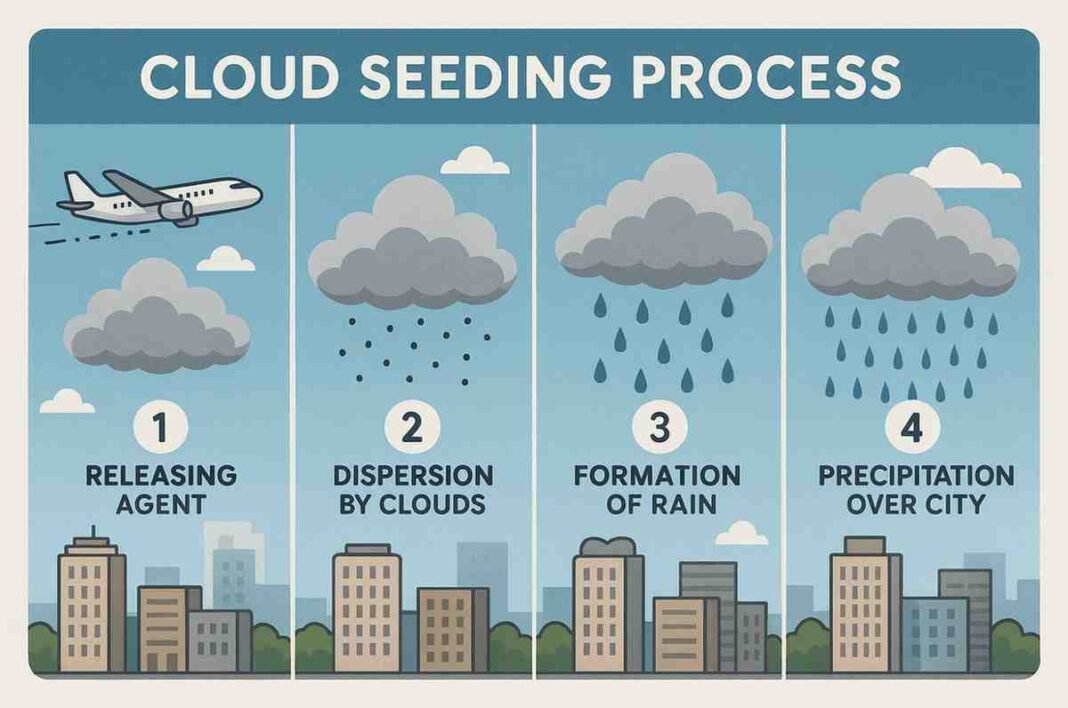Cloud Seeding in Delhi Likely Within Days as Air Quality Worsens
As Delhi’s air quality continues to decline in the days leading up to Diwali, the city government is preparing to launch cloud seeding operations — an artificial rain initiative — within the next two to three days. Delhi Environment Minister Manjinder Singh Sirsa announced on Wednesday that if weather conditions are favourable, the plan will be executed immediately, marking one of the capital’s most ambitious attempts to combat its annual pollution crisis.
The move comes as the Commission for Air Quality Management (CAQM) enforced restrictions under the Graded Response Action Plan (GRAP) Stage-I, after the Air Quality Index (AQI) in the city crossed 200 — a level categorised as “poor.” Implemented ahead of Diwali, GRAP is designed to reduce pollution through measures such as restrictions on construction and increased surveillance on industrial emissions.
Pollution Control Measures Before Diwali
This year, Delhi’s environmental strategy appears to be multi-pronged, combining cloud seeding, GRAP protocols, and regulated use of green crackers. The Supreme Court recently granted permission for the sale and use of green crackers during Diwali, aiming to maintain a balance between environmental protection and festive celebration.
Speaking about the initiative, Minister Sirsa said, “If weather conditions are apt in the coming two to three days, and with IMD’s approval, we will be ready within three hours to conduct the cloud seeding exercise.” He also mentioned that pilot training for the project had already been completed and that preparations were in place for quick deployment.
Sirsa added that despite challenges such as over-aged vehicles on Delhi’s roads, the government had managed to achieve relatively clear skies for most of the year. However, he acknowledged that the post-monsoon period and festival season often trigger a spike in pollution due to stubble burning, vehicular emissions, and firecracker use.
Understanding Cloud Seeding
Cloud seeding is a weather modification technique that involves dispersing special substances such as silver iodide, dry ice, and iodised salt into clouds to induce rainfall or snowfall. This is achieved through aircraft, rockets, or ground-based generators. The moisture in clouds reacts with these particles, leading to the formation of raindrops, thereby artificially enhancing precipitation.
In Delhi’s case, the formulation being used was developed by IIT Kanpur, comprising silver iodide nanoparticles, iodised salt, and rock salt. The goal is to settle airborne pollutants by triggering rainfall, which can temporarily wash away particulate matter like PM2.5 and PM10 from the atmosphere.
While cloud seeding cannot solve pollution permanently, it can provide short-term relief during periods of extreme smog. Similar experiments have been conducted in cities such as Beijing, Dubai, and Los Angeles, with varying degrees of success.
Previous Attempts and Challenges
Delhi’s first proposal for cloud seeding dates back several months. Initially, the plan was to conduct the exercise between July 4 and 11, but it was postponed after experts raised concerns about carrying out such an operation during the monsoon, when pollution levels are typically lower.
Following recommendations from the India Meteorological Department (IMD) and the Indian Institute of Tropical Meteorology (IITM), Pune, the government shifted the timeframe to between August 30 and September 10, when cloud conditions were expected to be optimal. However, unfavourable weather conditions delayed the process further.
Now, with the onset of winter and the visible rise in pollution, Delhi officials are optimistic that suitable cloud formations over the next few days could finally make the operation possible.
Delhi’s Persistent Air Pollution Problem
Despite numerous measures, Delhi continues to be India’s most polluted megacity. According to an analysis by the Centre for Science and Environment (CSE), the city’s average PM2.5 concentration during the 2024–25 winter season stood at 175 micrograms per cubic metre, several times higher than the World Health Organisation’s safe limit.
A separate study by the Energy Policy Institute at the University of Chicago (EPIC) found that air pollution in Delhi is reducing the life expectancy of residents by nearly 12 years compared to WHO guidelines. Experts warn that the combination of crop residue burning in neighbouring states, vehicular emissions, and industrial smoke contributes to this recurring crisis.
As the festive season approaches, the success of Delhi’s upcoming cloud seeding experiment will be closely watched — not only as a potential pollution control measure but also as a test of how science and governance can work together to combat the capital’s worsening air emergency.








